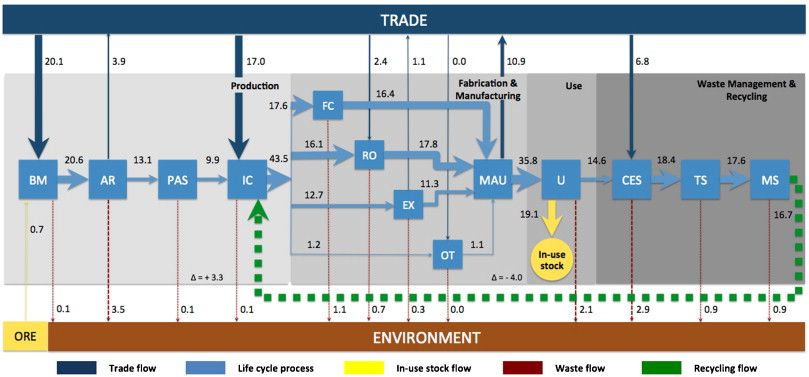Ciacci, Luca; Chen, Wei-Qiang*; Passarini, Fabrizio*; Eckelman, Matthew; Vassura, Ivano; Morselli, Luciano
Resources, Conservation and Recycling 2013 72, 1-8. DOI: 10.1016/j.resconrec.2012.12.004
Abstract
Dynamic stocks and flows analysis was applied to the anthropogenic aluminum cycle in Italy in order to detect and quantify metal flows and in-use stocks over the years 1947–2009. The model utilized a top-down approach, including data for production, consumption, loss, and trade flows of aluminum. Seven end-use markets were considered, namely buildings and construction, transportation, consumer durables, machinery and equipment, electrical engineering, containers and packaging, and miscellaneous appliance types. The results of this dynamic stocks and flows analysis model quantified the contemporary anthropogenic reservoirs (or in-use stocks) of aluminum at about 320 kg per capita, mainly embedded within the transportation and building and construction sectors. Cumulative in-use stock represents approximately 11 years of supply at current usage rates (about 20 Mt versus 1.7 Mt/year), implying significant potential for recycling in the future as this stock comes out of use. Flow analysis revealed that Italy imports mainly unwrought aluminum and exports final products, while the main material losses occur during alumina refining and collection of old scrap: specifically, containers and packaging have the highest old scrap generation rate, but for the lowest recovery rate (50%). Increasing support to collection of scrap and initiatives oriented to aluminum recovery specifically would allow Italy to increase its reliance on domestic material, and may also allow a decline of the country import-dependence on primary sources. The dynamic stocks and flows model created here provides a quantitative historical record of the aluminum required by Italian society during important periods of development and provides guidance for future decision-making around the use of domestic secondary resources.
Aluminum life cycle in Italy: cumulative flows and stocks, years 1947–2009.
